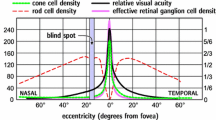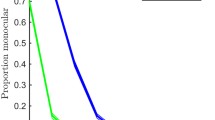Abstract
A series of psychophysical tests were designed to determine whether a computer simulation of the human retina could accurately predict the geometry of various stimuli that were optimally resolved for human foveal vision. Stimuli were used that were of the order of the grain of the cone mosaic, i.e., of the order of 2 × 2′. In the first set of experiments, resolution was tested using a two-bar stimulus. In one experimental series the gap between the two bars was varied, and in a second series the gap was kept constant and the width of the bars varied. In a second set of experiments, various block letters and a number of series for each letter were used; in each experimental series a single parameter was systematically varied. The same stimuli were also used as inputs for the computer simulation. When proper controls were used, the psychophysical data and computer simulation gave remarkably comparable results. Care was taken to differentiate between simple detection of a pattern, and resolution, which involved proper identification of the image.
Similar content being viewed by others
References
Craik KJW (1939) The effect of adaptation on visual acuity. Br J Psychol 29:252–266
Fahle M, Edelman S (1993) Long-term learning in vernier acuity: effects of stimulus orientation, range and of feedback. Vision Res 33:397–412
Jaschinski-Kruza W (1990) Effects of stimulus distance on measurements of dark convergence. Ophthalmic Physiol Opt 10:243–251
Olzak LA, Thomas JP (1986) Seeing spatial patterns. In: Boff KR, Kaufman L, Thomas JP (eds) Handbook of perception and human performance. (Sensory process and perception, vol 1). Wiley, New York, pp 1–56
Siminoff R (1991a) Simulated bipolar cells in fovea of human retina. I. Computer simulation. Biol Cybern 64:497–504
Siminoff R (1991b) Simulated bipolar cells in fovea of human retina. II. Spectral responses of bipolar cells. Biol Cybern 64:505–510
Siminoff R (1991c) Simulated bipolar cells in fovea of human retina. III. Effects of chromatic adaptation on bipolar cell spectral responses. Biol Cybern 65:357–364
Siminoff R (1991d) Simulated bipolar cells in fovea of human retina. IV. Resolution. Biol Cybern 66:123–135
Siminoff R (1991e) Simulated bipolar cells in fovea of human retina. VI. Wavelength discrimination. Biol Cybern 65:365–374
Siminoff R (1991f) Simulated bipolar cells in fovea of human retina. V. Use of Fourier analysis to determine resolution. Biol Cybern 66:137–150
Sloan LL (1968) The photopic acuity-luminance function with special reference to parafoveal vision. Vision Res 8:901–911
Author information
Authors and Affiliations
Rights and permissions
About this article
Cite this article
Siminoff, R., Cavonius, C.R. Simulated fovea of the human retina: psychophysical data confirming the model's ability to accurately predict resolution. Biol. Cybern. 69, 475–484 (1993). https://doi.org/10.1007/BF01185419
Received:
Accepted:
Issue Date:
DOI: https://doi.org/10.1007/BF01185419




